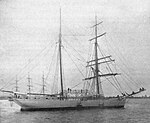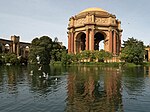Fort Mason, in San Francisco, California originated as a coastal defense site during the American Civil War. The nucleus of the property was owned by John C. Frémont and disputes over compensation by the United States continued into 1968. In 1882 the defenses were named for Richard Barnes Mason, a military governor before statehood. Fort Mason became the headquarters for an Army command that included California and the Hawaiian Islands from 1904 to 1907. In 1912 the Army began building a port facility with piers and warehouses to be a home base for ships of the Army Transport Service serving Alaska, Hawaii, the Philippines and other Pacific Army posts and focus of Army supply for the Pacific.
On 6 May 1932 that port facility was designated the San Francisco Port of Embarkation, modeled on the New York Port of Embarkation which supplied U.S. Army forces in World War I, to serve the Pacific. Fort Mason then became both the headquarters of the command that was the San Francisco Port of Embarkation and an element of that command. The San Francisco Port of Embarkation assumed responsibility for the Army Transport Service, the San Francisco General Quartermaster Depot at Fort Mason and the Overseas Replacement and Discharge Service at Fort McDowell, California. When war came to Europe in 1939 the New York Port of Embarkation was again operating as a port of embarkation on a World War I scale with associated camps and facilities and sub ports soon to be established. On the Pacific only the port at San Francisco was operating. The Army recognized that the relatively small port facility at Fort Mason was inadequate for supporting major wartime operations in the Pacific. In early 1941 the Army began acquiring land and facilities for major expansion in Oakland, Seattle and elsewhere in the San Francisco area. By the end of the war Fort Mason and thirteen other facilities composed the San Francisco Port of Embarkation.
The San Francisco Port of Embarkation was the second largest of eight Ports of Embarkation through World War II and was disestablished 1 October 1955. It then became headquarters for the Pacific Transportation Terminal Command. It is a former United States Army post located in the northern Marina District, alongside San Francisco Bay. Fort Mason served as an Army post for more than 100 years, initially as a coastal defense site and subsequently as a military port facility. During World War II, it was the principal port for the Pacific campaign.Today it is part of the Golden Gate National Recreation Area and the site of several cultural facilities. The entire fort area is listed as a historic district on the National Register of Historic Places, with 49 buildings of historic significance, spread over 1,200 acres (490 ha). while the lower port area is a National Historic Landmark District, designated for its role in World War II.










